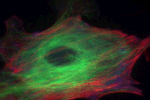Nanosurgery with femtosecond lasers
Photodisruption in turbid tissue with 100-fs and 200-ps laser pulses,
at
APS Centennial Meeting 1999 (Atlanta, GA),
Friday, March 26, 1999:
Single neuron dissection in C. elegans by femtosecond laser pulses,
at
Photonics West 2006 (San Jose, CA),
Saturday, January 21, 2006:
Subcellular surgery and nanosurgery,
at
Physics Colloquium, University of Kentucky (Lexington, KY),
Thursday, October 25, 2007:
Manipulating cells using ultrashort laser pulses,
at
Wednesday Night Research Seminar, Harvard University (Cambridge, MA),
Wednesday, September 9, 2009:
Subcellular surgery and nanosurgery,
at
Western Washington University (Bellingham, WA),
Tuesday, May 13, 2014:
Nanosurgery in live cells using ultrashort laser pulses,
at
2005 SPIE Photonics West Conference (San Jose, CA),
Tuesday, January 25, 2005:
Probing cell mechanics with femtosecond laser pulses,
at
Photonics West 2007 (San Jose, CA),
Sunday, January 21, 2007:
Subcellular surgery and nanosurgery,
at
Special Laser Seminar / NCCR MUST Seminar, ETH Zürich (Zürich, Switzerland),
Thursday, February 23, 2012:
Photodisruption in biological samples using femtosecond laser pulses,
at
Photonic West Conference (San Jose, CA),
Tuesday, January 23, 2001:
Subcellular surgery and nanosurgery,
at
CIMIT/Lester Wolfe Workshop on Femtosecond Microscopy & Microsurgery, Wellman Center for Photomedicine (Boston, MA),
Tuesday, April 18, 2006:
Subcellular surgery and nanosurgery,
at
Phi Beta Kappa Lecture, Pomona College (Claremont, CA),
Tuesday, April 15, 2008:
Subcellular surgery and nanosurgery,
at
PR-LSAMP Role Model Series, UPR Rio Piedras (Rio Piedras, PR),
Friday, February 19, 2010:
Shining light on cells to cure diseases,
at
SPIE LASE Photonics West 2017 (San Francisco, CA),
Sunday, January 29, 2017:
High Throughput Poration of Mammalian Cells using Femtosecond Laser-activated Plasmonic Substrates,
at
Tokyo Metropolitan University (Tokyo, Japan),
Thursday, January 29, 2015:
Femtosecond laser dissection of neurons in C. elegans,
at
Industrial Outreach Program, Harvard University (Cambridge, MA),
Wednesday, April 27, 2005:
 The detailed architecture of spindle microtubules, involved in cell division, was revealed using femtosecond laser nanosurgery. This work was performed in collaboration with the Needleman group (results published in Cell).
The detailed architecture of spindle microtubules, involved in cell division, was revealed using femtosecond laser nanosurgery. This work was performed in collaboration with the Needleman group (results published in Cell).